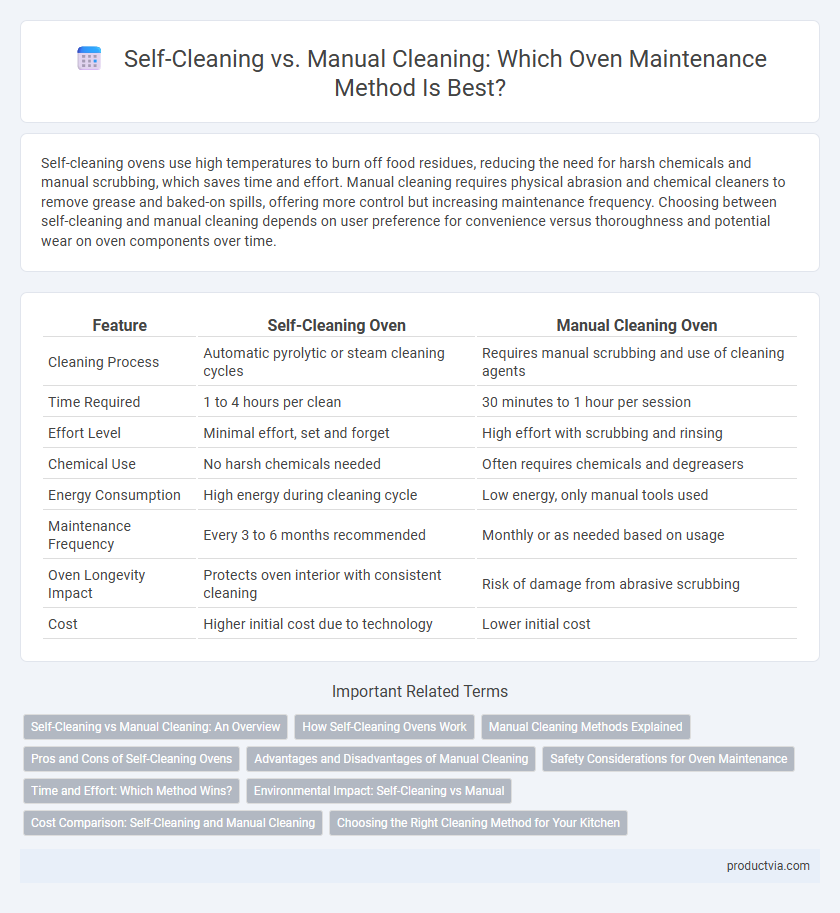Self-cleaning ovens use high temperatures to burn off food residues, reducing the need for harsh chemicals and manual scrubbing, which saves time and effort. Manual cleaning requires physical abrasion and chemical cleaners to remove grease and baked-on spills, offering more control but increasing maintenance frequency. Choosing between self-cleaning and manual cleaning depends on user preference for convenience versus thoroughness and potential wear on oven components over time.
Table of Comparison
| Feature | Self-Cleaning Oven | Manual Cleaning Oven |
|---|---|---|
| Cleaning Process | Automatic pyrolytic or steam cleaning cycles | Requires manual scrubbing and use of cleaning agents |
| Time Required | 1 to 4 hours per clean | 30 minutes to 1 hour per session |
| Effort Level | Minimal effort, set and forget | High effort with scrubbing and rinsing |
| Chemical Use | No harsh chemicals needed | Often requires chemicals and degreasers |
| Energy Consumption | High energy during cleaning cycle | Low energy, only manual tools used |
| Maintenance Frequency | Every 3 to 6 months recommended | Monthly or as needed based on usage |
| Oven Longevity Impact | Protects oven interior with consistent cleaning | Risk of damage from abrasive scrubbing |
| Cost | Higher initial cost due to technology | Lower initial cost |
Self-Cleaning vs Manual Cleaning: An Overview
Self-cleaning ovens use high temperatures to turn food residue into ash, offering a hands-free cleaning experience that reduces scrubbing time and effort. Manual cleaning requires specialized cleaners and physical scrubbing, which can be labor-intensive but allows for more precise control over cleaning specific stains or residue. Choosing between self-cleaning and manual cleaning depends on the oven model, user convenience preferences, and sensitivity to cleaning chemicals.
How Self-Cleaning Ovens Work
Self-cleaning ovens use high temperatures around 900degF (482degC) to burn off food residue, turning it into ash that can be easily wiped away. This pyrolytic cleaning process eliminates the need for harsh chemicals and extensive scrubbing required in manual cleaning. Self-cleaning cycles typically last 2 to 4 hours, providing a convenient and efficient maintenance method for maintaining a clean oven interior.
Manual Cleaning Methods Explained
Manual cleaning methods for ovens involve using specialized oven cleaners, baking soda paste, or vinegar solutions to break down grease and burnt residues effectively. Scrubbing with non-abrasive sponges and soft cloths helps preserve the oven's interior coating while removing stubborn stains and food particles. Regular manual cleaning prevents build-up, extending the lifespan of oven components and ensuring optimal cooking performance.
Pros and Cons of Self-Cleaning Ovens
Self-cleaning ovens feature high-temperature cycles that burn off food residue, reducing manual scrubbing and saving time. They provide convenience and reduce the use of harsh chemical cleaners but can consume significant energy and emit smoke or odors during the cleaning process. However, self-cleaning cycles may pose risks to certain oven components and can be more expensive upfront than manual-cleaning models.
Advantages and Disadvantages of Manual Cleaning
Manual cleaning offers precise control over stubborn stains and grease buildup on oven surfaces, allowing targeted removal without risking damage to sensitive components. It requires more time and physical effort compared to self-cleaning, often involving strong chemical agents that may pose health hazards and necessitate proper ventilation. While manual cleaning avoids the high temperatures that can strain oven parts during self-clean cycles, it demands consistent attention to maintain hygiene and prevent residue accumulation.
Safety Considerations for Oven Maintenance
Self-cleaning ovens utilize high-temperature cycles to burn off residues, reducing the risk of chemical exposure compared to manual cleaning with harsh solvents. Manual cleaning requires careful handling of abrasive cleaners and sharp tools, increasing the chance of skin irritation or injury. Prioritizing safety, users should follow manufacturer guidelines, wear protective gloves, and ensure proper ventilation during any cleaning process.
Time and Effort: Which Method Wins?
Self-cleaning ovens reduce maintenance time significantly by using high temperatures to burn off residue, requiring minimal effort beyond wiping away ash. Manual cleaning demands more time and physical labor, involving scrubbing with chemicals or natural cleaners to remove grease and food buildup. For those prioritizing convenience, self-cleaning ovens offer greater efficiency, while manual cleaning allows more control but at the expense of time and effort.
Environmental Impact: Self-Cleaning vs Manual
Self-cleaning ovens utilize high temperatures to burn off food residue, reducing the need for harsh chemical cleaners and minimizing water usage, which lowers environmental impact. Manual cleaning often involves chemical detergents and significant water consumption, contributing to pollution and increased resource depletion. Choosing self-cleaning technology can lead to reduced chemical waste and energy efficiency, promoting eco-friendly kitchen maintenance.
Cost Comparison: Self-Cleaning and Manual Cleaning
Self-cleaning ovens typically incur higher upfront costs due to advanced technology but reduce long-term expenses by minimizing the need for cleaning agents and labor. Manual cleaning ovens have lower initial prices but often require frequent purchase of cleaning supplies and more time investment, increasing ongoing maintenance costs. Over time, self-cleaning systems offer cost efficiency, especially for heavy users, by lowering operational and maintenance expenses compared to manual cleaning methods.
Choosing the Right Cleaning Method for Your Kitchen
Self-cleaning ovens use high temperatures to burn off food residue, reducing manual effort and offering convenience for busy kitchens. Manual cleaning requires scrubbing with specialized cleaners, providing thorough removal of stubborn stains and preventing damage to oven surfaces. Selecting the right cleaning method depends on oven type, usage frequency, and preference for maintenance intensity to ensure optimal kitchen hygiene and appliance longevity.
Self-cleaning vs Manual cleaning for maintenance Infographic

 productvia.com
productvia.com